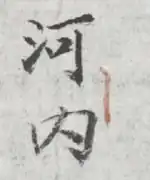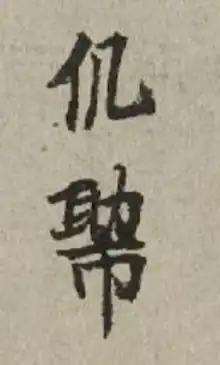Chữ Hán
Chữ Hán[1] (𡨸漢, literally "Han characters", Vietnamese pronunciation: [t͡ɕɨ˦ˀ˥ haːn˧˦]), chữ Nho (𡨸儒, literally "Confucian characters", Vietnamese pronunciation: [t͡ɕɨ˦ˀ˥ ɲɔ˧˧]) or Hán tự[lower-alpha 1] (漢字, Vietnamese pronunciation: [haːn˧˦ tɨ˧˨ʔ]) are the Vietnamese terms for Chinese characters, used to write Literary Chinese (known as Hán văn 漢文 or văn ngôn 文言 in Vietnamese) and Sino-Vietnamese vocabulary in the Vietnamese language. They were officially used in Vietnam after the Red River Delta region was incorporated into the Han dynasty and continued to be used until the early 20th century (111 BC – 1919 AD) where usage of Literary Chinese was abolished alongside the Confucian court examinations causing chữ Hán to fall into obscurity.
| Chữ Hán Chữ Nho | |
|---|---|
 Chữ Hán and chữ Nho written in chữ Nôm, with chữ Quốc ngữ on the right. | |
| Script type | |
Time period | 3rd century BC – 20th century AD, present (limited usage) |
| Direction | Top-to-bottom, columns from right to left (traditional) |
| Languages | Literary Chinese, Vietnamese (written in chữ Nôm) |
| Related scripts | |
Parent systems | |
Child systems | Chữ Nôm |
Sister systems | Kanji, Hanja, Zhuyin, traditional Chinese, simplified Chinese, Khitan script, Jurchen script, Tangut script, Yi script |
History
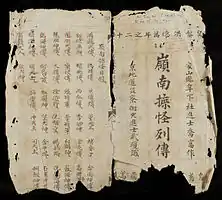
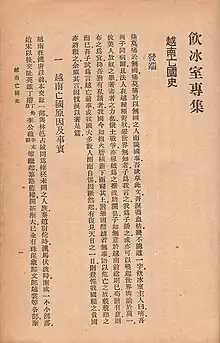
After the conquest of Nanyue (Vietnamese: Nam Việt; chữ Hán: 南越), parts of modern-day Northern Vietnam were incorporated into the Jiāozhǐ province (Vietnamese: Giao Chỉ; chữ Hán: 交趾) of the Han dynasty. It was during this era, that the Red River Delta was under direct Chinese rule for about a millennium. Around this time, Chinese characters became widespread in Northern Vietnam. Government documents, literature, and religious texts such as Buddhist sutras were all written in Literary Chinese (Vietnamese: Hán văn; chữ Hán: 漢文).[2] From independence from China and onward, Literary Chinese still remained as the official language for writing whether if it was government documents or literature.[3] Every succeeding dynasty modeled their imperial exams after China's model. Scholars drew lessons from Neo-Confucianism and used its teachings to implement laws in the country. The spread of Confucianism meant the spread of Chinese characters, thus the name for Chinese characters in Vietnamese is called chữ Nho (literally: 'Confucian characters; 𡨸儒).[4] Scholars were focused on reading Chinese classics such as the Four Books and Five Classics. While literature in Vietnamese (written with chữ Nôm) was the minority. Literature such as Nam quốc sơn hà (chữ Hán: 南國山河) and Truyền kỳ mạn lục (chữ Hán: 傳奇漫錄) being written with Chinese characters. With every new dynasty with the exception of two dynasties,[lower-alpha 2] Literary Chinese and thus Chinese characters remained in common usage.
It was until in the 20th century that Chinese characters alongside chữ Nôm began to fall into disuse. The French Indochinese administration sought to civilise and modernise Vietnam by abolishing the Confucian court examinations. During this time, the French language was used for the administration. The French officials favoured Vietnamese being written in the Vietnamese alphabet. Chinese characters were still being taught in classes (in South Vietnam) up to 1975, but failed to be a part of the new elementary curriculum complied by Ministry of Education and Training after the Vietnam War.[5]

Today, Chinese characters can still be seen adorned in temples and old buildings. Chữ Hán is now relegated to obscurity and cultural aspects of Vietnam. During Vietnamese festivals, calligraphists will write some couplets written in Chinese characters wishing prosperity and longevity.
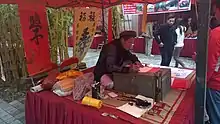
Education
In the preface of Khải đồng thuyết ước (啟童說約; 1853) written by Phạm Phục Trai (范复齋), it has the passage,[6]
余童年,先君子從俗命之,先讀《三字經》及三皇諸史,次則讀經傳,習時舉業文字,求合場規,取青紫而已。
Dư đồng niên, tiên quân tử tùng tục mệnh chi, tiên độc “Tam tự kinh” cập Tam Hoàng chư sử, thứ tắc độc kinh truyện, tập thì cử nghiệp văn tự, cầu hợp trường quy, thủ thanh tử nhi dĩ.
(In my childhood, under the guidance of my elders and conforming to the customs, I first studied the "Three Character Classic" and various histories of the Three Emperors. Afterward, I delved into the classics and their commentaries, honing my skills in calligraphy and writing, aiming to conform to the rules of society and attain a respectable status.')
Historically, several different textbooks were used traditionally to teach children chữ Hán such as Nhất thiên tự 一千字, Tam thiên tự 三千字, Ngũ thiên tự 五千字, etc. These books used rhymes alongside glosses in vernacular Vietnamese (written in chữ Nôm) to teach Chinese characters.[7] Other books include Three Character Classic 三字經, Sơ học vấn tân 𥘉學問津, Ấu học ngũ ngôn thi 幼學五言詩, Minh tâm bảo giám 明心寶鑑, and Minh Đạo gia huấn 明道家訓.[8] These books taught the characters necessary to read Literary Chinese and taught core Confucian values and concepts such as filial piety.

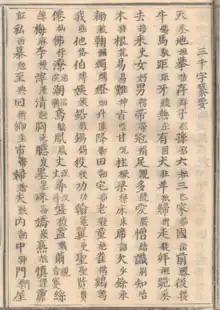

During the period of reformed imperial examinations (khoa cử cải lương; 科舉改良) that took place from 1906 to 1919, there were three grades of education. Students would start learning Chinese characters beginning from the age of 6. The first grade level was called ấu học 幼學 (ages 6–12), next was tiểu học 小學 (ages under 27), and then finally, trung học 中學 (ages under 30).[9] Đại học 大學 at this time referred to students studying in the national academies.
Uses
Names
In Vietnam, many provinces and cities have names that come from Sino-Vietnamese words and were written using Chinese characters. This was done because historically the government administration needed to have a way to write down these names, as some native names did not have characters. Even well-known places like Hanoi (河內) and Huế (化) were written in Chinese characters. Often, villages only had one word names in Vietnamese.
Some Sino-Vietnamese names were translated from their original names, like Tam Điệp Quan (三疊關) being the Sino-Vietnamese name for Đèo Ba Dội.
| Chinese characters | Sino-Vietnamese name (tên Chữ) | Chữ Nôm | Vietnamese name (tên Nôm) |
|---|---|---|---|
| 河內 | Hà Nội | 仉𢄂 | Kẻ Chợ |
| 紅河 | Hồng Hà | 滝𫡔 | Sông Cái |
| 嘉定 | Gia Định | 柴棍 | Sài Gòn |
| 傘園山 | Tản Viên Sơn | 𡶀𠀧位 | Núi Ba Vì |
Practically all surnames in Vietnamese are Sino-Vietnamese words; they were once written in Chinese characters. Such names include Nguyễn 阮, Trần 陳, Lê 黎, Lý 李, etc.[lower-alpha 3]

Readings for characters

Owing to historical contact with Chinese characters before the adoption of Chinese characters and how they were adapted into Vietnamese, multiple readings can exist for a single character. While most characters usually have one or two pronunciations, some characters can have up to as many as four pronunciations and more. An example of this would be the character 行 hàng – which could have the readings hàng, hành, hãng, hạng, and hạnh.[10][lower-alpha 4] The readings typically depend on the context and definition of the word. If talking about a store or goods, the reading hàng would be used, but if talking about virtue, the reading hạnh would be used. But typically, knowing what readings was not a large problem due to context and compound words. Most Sino-Vietnamese words are restricted to being in compound words. Readings for chữ Hán, often classified into Sino-Vietnamese readings and Non-Sino-Vietnamese readings. Non-Sino-Vietnamese readings are derived from Old Chinese and recent Chinese borrowings during the 17th–20th centuries when Chinese people migrated to Vietnam.[11] Most of these readings were food related as Cantonese Chinese had introduced their food into Vietnam. Borrowings from Old Chinese are also referred to as Early Sino-Vietnamese pronunciations according to Mark Alves.[12]
Sino-Vietnamese readings
Sino-Vietnamese readings are usually referred to as âm Hán Việt (音漢越; literally "sound Sino-Vietnamese"),[13][14] which are Vietnamese systematic pronunciations of Middle Chinese characters.[15] These readings were largely borrowed into Vietnamese during the late Tang dynasty (618-907). Vietnamese scholars used Chinese rime dictionaries to derive consistent pronunciations for Chinese characters.[16] After Vietnam had regained independence, its rulers sought to build the country on the Chinese model, during this time, Literary Chinese was used for formal government documents.[17] Around this, the Japanese and Koreans also borrowed large amount of characters into their languages and derived consistent pronunciations, these pronunciations are collectively known as the Sino-Xenic pronunciations.[15]
| Chinese characters | Sino-Vietnamese | Standard Chinese | Cantonese | Sino-Japanese | Sino-Korean |
|---|---|---|---|---|---|
| 準備 'to prepare' | chuẩn bị | zhǔnbèi | zeon2bei6 | junbi | junbi |
| 電話 'telephone' | điện thoại | diànhuà | din6waa6-2 | denwa | jeonhwa |
| 四 'four' | tứ, tư | sì | sei3, si3 | shi | sa |
| 人民 ' people' | nhân dân | rénmín | jan4man4 | jinmin | inmin |
| 地名 'place name' | địa danh | dìmíng | dei6meng4-2 | chimei | jimyeong |
| 言語 'language' | ngôn ngữ | yányǔ | jin4jyu5 | gengo | eoneo |
| 中國 'China' | Trung Quốc | Zhōngguó | Zung1gwok3 | Chūgoku | Jungguk |
| 日本 'Japan' | Nhật Bản | Rìběn | Jat6bun2 | Nihon | Ilbon |
Non-Sino-Vietnamese readings
Non-Sino-Vietnamese pronunciations are pronunciations that were not consistently derived from Middle Chinese.[18][19] Typically these readings came from Old Chinese, Cantonese, and other Chinese dialects.
| Chinese | Early Sino-Vietnamese | Sino-Vietnamese |
|---|---|---|
| 味 *mjəts > mjɨjH | mùi 'smell, odor' | vị 'flavor, taste' |
| 婦 *bjəʔ > bjuwX | vợ 'wife' | phụ 'woman' |
| 法 *pjap > pjop | phép 'rule, law' | pháp 'rule, law' |
| 劍 *kams > kɨɐmH | gươm 'sword' | kiếm 'sword' |
| 鏡 *kraŋs > kˠiæŋH | gương 'mirror' | kính 'glass for windows, etc.; eyeglasses' |
| 茶 *rlaː > ɖˠa | chè 'tea or a dessert soup' | trà 'tea' |
| 車 *kʰlja > t͡ɕʰia | xe 'wheeled vehicle' | xa 'rare form of xe' |
| 夏 *ɡraːʔ > ɦˠaX | hè 'summer' | hạ '(literary) summer' |
Nôm readings
Nôm readings (âm Nôm; 音喃)[20][21] were used when there were characters that were phonetically close to a native Vietnamese word's pronunciation would be used as a chữ Nôm character.[22] Most chữ Hán characters that were used for Vietnamese words were often used for their Sino-Vietnamese pronunciations rather than their meaning which could be completely different from the actual word being used. These characters were called chữ giả tá (phonetic loan characters),[21] due to them being borrowed phonetically. This was one reason why it was preferred to create a chữ Nôm character rather than using a chữ Hán character causing confusion between pronunciations.
| Chinese character and Standard Chinese pronunciations | Sino-Vietnamese pronunciations | Sino-Vietnamese meaning | Nôm pronunciations | Nôm meaning |
|---|---|---|---|---|
| 些 'xiē' | ta, tá | some; a few; a little; a bit | ta[23] | I, me, we |
| 朱 'zhū' | chu, châu | cinnabar; vermilion | cho[24] | to give, to let, to put; for |
| 別 'bié' | biệt | to divide; to separate | biết[25] | to know |
| 碎 'suì' | toái | shattered; fragmented; shredded | tôi[26] | I, me |
| 羅 'luó' | la | net for catching birds | là[27] | to be, is |
| 嘲 'cháo' | trào | to ridicule; to deride; to scorn; to jeer at | chào[28] | hello, bye |
Types of characters
Chữ Hán can be classified into the traditional classification for Chinese characters, this is called lục thư[29] (六書, Chinese: liùshū), meaning six types of Chinese characters. The characters are largely based on 214 radicals set by the Kangxi Dictionary.[30]
- Chữ chỉ sự (𡨸指事) – Ideogram, an example would be 上 (thượng, “above”) and 下 (hạ, “below”).[31]
- Chữ tượng hình (𡨸象形) – Pictogram, an example would be 日 (nhật, "sun") and 木 (mộc, "tree").[32]
- Chữ hình thanh (𡨸形聲) – Phono-semantic compound, an example would be 銅 (đồng, "copper"; "currency") which is made up of semantic 金 [釒] (kim, "metal) and phonetic 同 (đồng).[33][lower-alpha 5]
- Chữ hội ý (𡨸會意) – Compound ideographs, an example would be 武 (vũ [võ], "military"; "martial") which is made up of 戈 (qua, "dagger-axe") and 止 (chỉ, “foot”; "to walk").[34]
- Chữ chuyển chú (𡨸轉注) – Derivative cognates, characters that were derived from other characters with similar meaning, an example would that 老 (lão, "old") is a cognate of 考 (khảo, "to examine").[35]
- Chữ giả tá (𡨸假借) – Phonetic loan, an example would be 法 (Pháp, "France") is used for the name of France. Other European countries are also referred by a chữ giả tá like 德 (Đức, "Germany") and 意 (Ý, "Italy").[36]
Variants
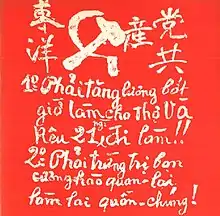
Some chữ Hán characters were simplified into variants of characters that were easier to write, but they are not the same simplified characters used by current-day Chinese. According to Trịnh Khắc Mạnh, when he analysed the early 13th century book, 釋氏寶鼎行持秘旨全章 (Thích thị Bảo đỉnh hành trì bí chỉ toàn chương). He found that the number of character variants is double the number of variants borrowed from China.[37] This means that Vietnamese variant characters may differ from Chinese variants and simplified characters, for example:
- The word 羅 la[lower-alpha 6] is simplified into 罗 in Chinese, but it is different in Vietnamese, 𱺵 (⿱罒𪜀). Other variants include 𦉼 (⿱罒大) and 𪜀 (⿻十ㄣ).
- Another example would be the character 沒 một which is simplified into 没 in Chinese and was simplified from 沒 to 𱥺 (⿰氵𠬠), then finally, 𠬠 (⿱丷又).
- The word 濫 lạm was simplified into 滥 in Chinese, but was simplified from 濫 to 滥 to 𪵯 (⿰氵𫜵) to 𫜵 (⿴𰀪⺀) in Vietnamese.[38]
Some characters matching Simplified Chinese do exist, but these characters are rare in Vietnamese literature.
There are other variants such as 𭓇 học (variant of 學; ⿳⿰〢⿻丨𰀪冖子) and 𱻊 nghĩa (variant of 義; ⿱𦍌又).[39]
Another prominent example is the character, 𫢋 phật (⿰亻天) which is a common variant of the character 佛 meaning 'Buddha'. It is composed of the radicals, 人 nhân [亻] and 天 thiên, all together to mean 'heavenly person'.[40][41]

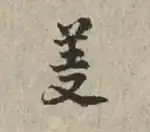
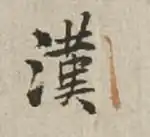
Symbols
The character 匕 (chuỷ) or 〻 is often used as an iteration mark to indicate that the current chữ Hán character is to be repeated. This is used in words that use reduplication. For example, in the poem Chinh phụ ngâm khúc (征婦吟曲), the character 悠 (du) is repeated twice in the third line of the poem. It is written as 悠〻 to represent 悠悠 (du du).
| chữ Quốc ngữ "Endlessly distant is that azure sky; who created its cause" | ||||||||||||||||
|---|---|---|---|---|---|---|---|---|---|---|---|---|---|---|---|---|
|
The way the marker is used is very similar to how Chinese and Japanese use their iteration marker 々. Japanese uses 々 as an iteration marker, so, for example, 人人 (hitobito) would be written as 人々 (hitobito).
See also
- Chữ Nôm
- Literary Chinese in Vietnam
- History of writing in Vietnam
- Chinese characters
- East Asian cultural sphere
- Kanji – Japanese equivalent of Chinese characters
- Hanja – Korean equivalent of Chinese characters
- Sino-Vietnamese vocabulary
- Tự Đức thánh chế tự học giải nghĩa ca - Literary Chinese - Vietnamese dictionary
Notes
- Hán tự is an uncommon term for Chinese characters. In late 19th-early 20th century and modern-day Vietnamese, chữ Hán, along with chữ Nho and chữ Tàu, have been the dominant terms for "Chinese characters". Hán tự started being used due to its perceived archaism.
- The Hồ dynasty (茹胡) and the Tây Sơn dynasty (茹西山) are the only two dynasties that used chữ Nôm officially unlike other dynasties that used Literary Chinese instead.
- Native names do exist, but are rare. Some examples include Giỏi, Sen, Gái, Nễ, etc.
- This is not including Nôm readings such as hàng, hành, hăng, and ngành.
- Also known as chữ hài thanh (𡨸諧聲); tượng thanh (象聲).
- The Nôm reading of the character is là 'to be'. 羅 is a very common character in Nôm texts.
References
- The Routledge Handbook of Translation and Politics. Routledge. April 26, 2018. p. 511. ISBN 978-1138657564.
Discussing the history of translation in Vietnam without mentioning the history of the Vietnamese written languages would be a mistake because the systems of written language in Vietnam passed through three stages: Chữ Hán (Chinese characters), Nôm (ideograms specific to Vietnam) and Chữ quốc ngữ (modern Vietnamese, written using adapted Latinate scrpit.
- Handel, Zev (2019). Sinography: The Borrowing and Adaptation of the Chinese Script. BRILL. p. 125. ISBN 9789004386327.
- Handel, Zev (2019). Sinography: The Borrowing and Adaptation of the Chinese Script. BRILL. p. 126. ISBN 9789004386327.
- Li, Hanke (2022). "The Construction of National Identity from the Perspective of the Change of Chinese Status in Vietnamese Language Policy". pp. 175–176.
- Nguyễn, Tuấn Cường (7 October 2019). "Research of square scripts in Vietnam: An overview and prospects". SageJournals. p. 5.
- Nguyễn, Tuấn Cường (2015). "Giáo dục Hán văn bậc tiểu học tại Việt Nam thời xưa qua trường hợp sách Tam tự kinh". p. 15.
- Nguyễn, Đình Hòa. "Vietnamese phonology and Graphemic Borrowings from Chinese: The book of 3,000 characters Revisited" (PDF). The Mon-Khmer Studies Journal.
- Nguyễn, Tuấn Cường (2015). "Giáo dục Hán văn bậc tiểu học tại Việt Nam thời xưa qua trường hợp sách Tam tự kinh". p. 31.
- Nguyễn, Tuấn Cường (2015). "Giáo dục Hán văn bậc tiểu học tại Việt Nam thời xưa qua trường hợp sách Tam tự kinh". p. 30.
- "Tra từ: c=行 – Từ điển Hán Nôm". Từ điển Hán Nôm.
- Trần, Khánh (1993). The Ethnic Chinese and Economic Development in Vietnam. Institute of Southeast Asian Studies. ISBN 9789813016675.
- Alves, Mark (2017). "Identifying Early Sino-Vietnamese Vocabulary via Linguistic, Historical, Archaeological, and Ethnological Data". Bulletin of Chinese Linguistics.
- Trần, Uyên Thi (2005). "Thử tìm hiểu luật biến âm qua hai bản Nôm" (PDF). p. 3.
Về các âm Hán Việt, tức cách đọc bắt nguồn từ chữ Hán vào cuối đời Đường.
- Shimizu, Masaaki. "A Reconstruction of Ancient Vietnamese Initials Using Chữ Nôm Materials". NINJAL Research Papers: 135.
- Norman, Jerry (1988). Chinese. Cambridge University Press. ISBN 978-0-521-29653-3.
- Alves, Mark (2009). Loanwords in Vietnamese. De Gruyter Mouton. ISBN 978-3-11-021843-5.
- DeFrancis, John (1977). Colonialism and language policy in Viet Nam. Mouton. ISBN 978-90-279-7643-7.
- Lê, Văn Quán (1989). Tự học chữ Nôm (in Vietnamese). NXB Khoa học Xã Hội. p. 64.
Ở phần phân tích chữ Nôm, còn có trường hợp âm đọc bắt nguồn từ âm Hán Việt cổ hoặc âm Hán Việt Việt hóa, nhưng hiện nay chưa có đẩy đủ cứ liệu, cho nên, chúng tôi tạm xếp các trường hợp đó vào kiểu chữ Nôm đọc chệch âm.
- "Chữ Nôm Structure". Nôm Foundation.
âm phi Hán Việt
- Shimizu, Masaaki. "A Reconstruction of Ancient Vietnamese Initials Using Chữ Nôm Materials". NINJAL Research Papers: 137.
- Trần, Uyên Thi (2005). "Thử tìm hiểu luật biến âm qua hai bản Nôm" (PDF). p. 4.
Giả tá : mượn âm của một chữ Hán đọc trại đi thành âm Nôm. Thí dụ: 牢 lao > sao, 停 đình > dừng, 朗 lãng > rạng.
- Li, Yu. The Chinese Writing System in Asia: An Interdisciplinary Perspective. Routledge. ISBN 978-1-00-069906-7.
- "彌勒真經演音 • Di Lặc chân kinh diễn âm". 1944. p. 8.
- "彌勒真經演音 • Di Lặc chân kinh diễn âm". 1944. p. 6.
- "彌勒真經演音 • Di Lặc chân kinh diễn âm". 1944. p. 5.
- "集案翁潘佩珠 • Tập án ông Phan Bội Châu". 1920. p. 4.
- "彌勒真經演音 • Di Lặc chân kinh diễn âm". 1944. p. 7.
- "TRUYỆN KIỀU BẢN 1870". 1870. p. 11.
- Nguyễn, Khuê (2020). Tự học Hán văn (in Vietnamese) (10th ed.). NXB Đà Nẵng. pp. 18–24. ISBN 9786048450243.
- Nguyễn, Khuê (2020). Tự học Hán văn (in Vietnamese) (10th ed.). NXB Đà Nẵng. pp. 32–58. ISBN 9786048450243.
- Nguyễn, Khuê (2020). Tự học Hán văn (in Vietnamese) (10th ed.). NXB Đà Nẵng. p. 19. ISBN 9786048450243.
- Nguyễn, Khuê (2020). Tự học Hán văn (in Vietnamese) (10th ed.). NXB Đà Nẵng. pp. 18–19. ISBN 9786048450243.
- Nguyễn, Khuê (2020). Tự học Hán văn (in Vietnamese) (10th ed.). NXB Đà Nẵng. p. 22. ISBN 9786048450243.
- Nguyễn, Khuê (2020). Tự học Hán văn (in Vietnamese) (10th ed.). NXB Đà Nẵng. p. 20. ISBN 9786048450243.
- Nguyễn, Khuê (2020). Tự học Hán văn (in Vietnamese) (10th ed.). NXB Đà Nẵng. p. 21. ISBN 9786048450243.
Hứa Thận định nghĩa "Lập nên một đầu loại, đồng ý cùng nhận, như chữ 考 khảo, 老 lão".
- Nguyễn, Khuê (2020). Tự học Hán văn (in Vietnamese) (10th ed.). NXB Đà Nẵng. pp. 21–22. ISBN 9786048450243.
- Trịnh, Khắc Mạnh (11 October 2020). "Chinese character variants in Vietnam: A case study of characters in The Complete Secrets for Buddhist Monks in Practice of Precious Rites". SageJournals. p. 224.
In the past, like Japanese and Korean people, Vietnamese people adopted and used official and variant characters imported from China, but they also created their own variant characters. By analysing the Chinese character variants in the book titled The Complete Secrets for Buddhist Monks in Practice of Precious Rites, we have realised that the number of variants created in Vietnam is double the number of variants adopted from China.
- Chan, Eiso; Lee, Collins; Ngô, Thanh Nhàn (2020). "Request to dis-unify U+722B", in UTC Document Register" (PDF). Unicode.
- Nguyễn, Tuấn Cường (7 October 2019). "Research of square scripts in Vietnam: An overview and prospects". SageJournals. p. 6.
- Nguyễn, Tuấn Cường (7 October 2019). "Research of square scripts in Vietnam: An overview and prospects". SageJournals. p. 195.
For example, the character Phật/Fó 佛 'Buddha' is written 𠏹 (亻+西+國 = person from western country) or 𫢋 (亻+ 天 = heavenly person), not 𠑵 (西域哲人 = wise person from western region) and 仸 (亻+ 夭 = ogreish person) as it is in Chinese variants.
- Trịnh, Khắc Mạnh (11 October 2020). "Chinese character variants in Vietnam: A case study of characters in The Complete Secrets for Buddhist Monks in Practice of Precious Rites". SageJournals. p. 222.
The second variant, "𫢋", occurs 15 times; for example, in the following sentence: "化為𫢋(佛)𬽪(佛)給付" ("Become Buddha, Buddha will entrust immediately" [82b]).
